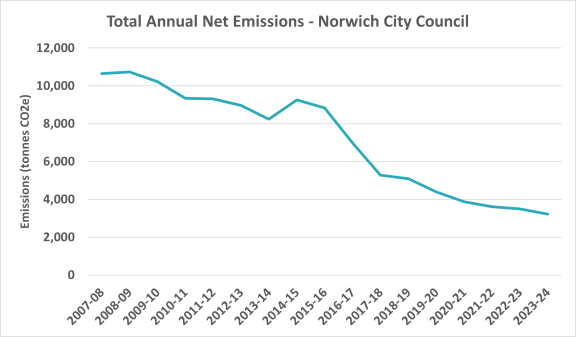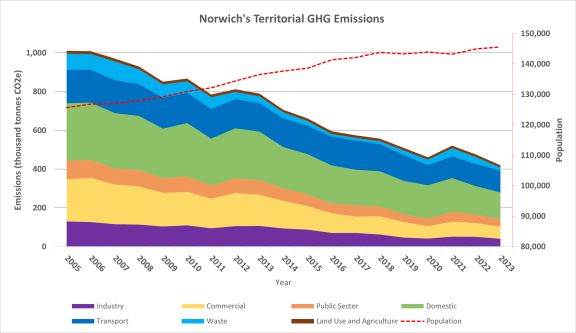Norwich’s climate action: what we’re doing and where we’re headed.
Norwich City Council declared a climate emergency in 2019 and launched an Environmental Strategy to guide our efforts through 2025. We're now working on a new strategy to help both the council and the city reach net zero emissions.
Our climate goals
- net zero council operations by 2030
- net zero Norwich by 2045
- greener parks and open spaces
- helping the city adapt to climate change
Progress so far
Council emissions
We’ve cut our carbon emissions by nearly 70% since 2007. In 2023/24, our emissions were down to 3,218 tonnes CO₂e - 8% less than the year before.

Key projects:
- £22 million in energy upgrades for council homes (2025–28), including solar panels and heat pumps.
- £5.1 million in grant-funded improvements completed for 260 council homes, adding solar panels and insulation.
- 724 solar panels installed at Riverside Leisure Centre - now powering over a third of the site’s electricity.
- City Hall upgrades with solar panels and a heat pump.
- 100% renewable electricity for all council buildings.
- More solar installations planned on public buildings.
- New emissions tracking starting in 2025 using international standards.
View our carbon footprint reports for 2022/23 and 2023/24.
Norwich’s citywide emissions
Norwich produces around 419,700 tonnes of CO2e each year – about 2.9 tonnes per person. Emissions have dropped significantly since 2005, even as the population has grown.
Citywide climate action:
- Leading the Norwich Climate Commission to coordinate efforts.
- Supporting Our Power, a community group helping residents save energy.
- Promoting Solar Together and Big Community Switch to make clean energy affordable.
- Secured £4.7 million to improve energy efficiency in 330 private homes.
- Exploring a Citywide Heat Network to reduce heating emissions.
- Expanding EV charging points with Norfolk County Council.
- Working on climate adaptation, including tree planting and water strategy planning.

What’s next
We’re preparing a new citywide climate action plan to map out how Norwich can reach net zero. Everyone in the city has a role to play - and we’re here to lead and support that journey.
Reports are shared quarterly with our Climate & Environment Emergency Executive Panel (CEEEP). View the latest reports.